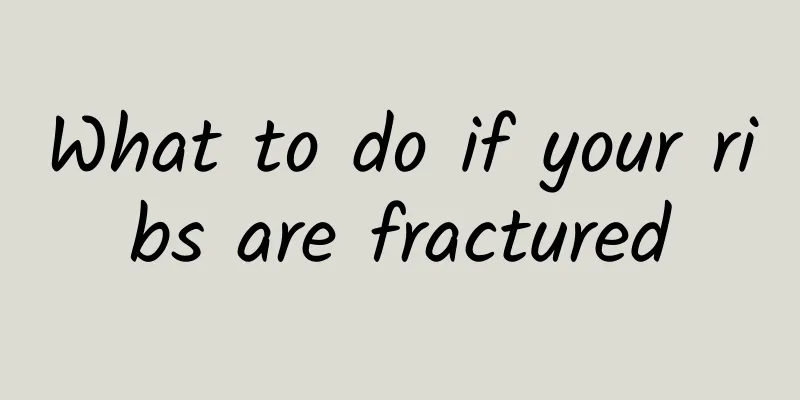What to do if your ribs are fractured

|
Rib fractures are also very common, especially among middle-aged and elderly people, but rarely among children. This is closely related to the increase in bone brittleness. Fractures have a great impact on physical health. Generally, people who experience such conditions cannot move. If such a situation occurs in the elderly, it may endanger their lives. So what should be done if ribs are fractured? Rib fractures are very painful and require timely treatment. You must also master some treatment principles and take some painkillers in time to avoid shock. At the same time, you must also prevent the occurrence of infection. What should you do if you have a rib fracture? Let's take a look at some effective treatments. Rib fractures occur in approximately 40-60% of chest injuries. It often occurs in middle-aged and elderly people and rarely in children. This is associated with increased bone fragility. Fractures can be caused by direct or indirect violence. Direct violent fractures often occur at the site where the ribs are directly hit. The sharp fracture ends shift inward and may puncture the intercostal blood vessels, pleura, lung tissue or upper abdominal organs, causing hemothorax, pneumothorax or hemopneumothorax, subcutaneous emphysema, hemoptysis, etc. Indirect violence (compression of the chest from front to back) fractures occur at locations other than the point of violence, often at the rib angles or rib bodies. The fracture ends are displaced outward, which can damage the soft tissue of the chest wall and cause chest wall hematomas. The most common rib fractures are the 4th to 7th ribs, because they are long and fixed and easy to break. The 1st to 3rd ribs are relatively short and are protected by the clavicle, scapula and muscles, so fractures rarely occur. Although the 8th to 10th ribs are relatively long, they are not directly connected to the sternum but are connected to the costal arch. They have elastic cushioning properties and are less likely to break. The 11th and 12th ribs are floating ribs, their front ends are free and not fixed, they have a greater range of motion, and fractures are even less common. However, these rib fractures can also be caused by strong external violence. Rib fractures can occur in a single rib or multiple ribs. The same rib can be broken in one or more places, or even multiple ribs (more than 3 ribs) can be fractured in multiple places, resulting in a "floating chest wall" and abnormal respiratory movements. And a larger area of "floating chest wall" seriously affects the respiratory reflux function, which may cause shortness of breath, cyanosis or difficulty breathing. If complicated by lung laceration, there may be hemoptysis, pneumothorax, hemothorax or subcutaneous emphysema. In elderly and frail patients, rib fractures may also be complicated by pneumonia and atelectasis. Rib fractures generally do not require reduction and fixation, and dislocation healing basically does not affect physiological function. The key to treating rib fractures is to relieve pain and prevent complications. What to do if your ribs are fractured Treatment principles To relieve pain, take painkillers, use 1% procaine intercostal nerve block or seal the fracture site. Local fixation and immobilization: (1) For closed single rib fractures, a multi-head chest strap, elastic chest strap or semi-ring wide tape can be used for overlapping fixation. (2) For closed multiple rib fractures, sandbags or gauze pads with elastic wrapping can be used to stabilize the floating chest wall or the patient can be asked to lie on the injured side. Maintain respiratory function, give oxygen when necessary, and encourage patients to cough to expectorate or sigh (blow) or take deep breaths regularly. If blood gas analysis shows insufficiency of ventilation and/or hypoxia, a ventilator should be used to assist breathing. Prevent and treat shock. Debridement should be carried out according to the principles of debridement. The debridement time for open rib fractures can be extended to 24-48 hours, depending on the degree of wound contamination. Prevention of infection: (1) Use antibiotics. (2) To prevent tetanus, tetanus antitoxin serum is routinely used for open rib fractures. Medication principles 1. For closed single rib fractures, analgesics can be taken orally or intramuscularly. For those who cannot tolerate severe pain, 1% procaine solution can be used to block the intercostal nerves or close the fracture. 2 For patients with closed multiple rib fractures, open rib fractures, or complications (other injuries), or the elderly and frail, such as those with traumatic shock or cardiopulmonary insufficiency, anti-shock drugs, cardiotonic and diuretics should be used, and antibiotics should be used to prevent infection. If there is hemorrhagic shock, blood transfusion and fluid infusion are required, and thoracotomy or appropriate treatment may be performed if necessary. 3. Patients with rib fractures should be given appropriate antibiotics to prevent lung infection and spray inhalation to facilitate expectoration. If the infection cannot be controlled by basic antibiotics, effective antibiotics or new special drugs can be selected to fight the infection based on bacterial culture and drug sensitivity tests. What to do if you have broken ribs? If you are still worried about what to do if you have broken ribs, then take a look at some of the methods we introduced today. I believe that many people will find these introductions very useful and want to try these methods quickly. Middle-aged and elderly people need to pay more attention in their daily lives to avoid broken ribs and other conditions. |
Recommend
Traditional Chinese medicine formula for treating facial paralysis
Facial paralysis is a disease caused by periphera...
Causes of ADHD in children
ADHD is a disease that occurs in children. This d...
Why can't my teeth bite hard things?
If your teeth cannot bite hard objects, it is mos...
Treatment of Hip Bursitis
Hip bursitis is a very common disease in daily li...
How big is the membrane removed after medical abortion?
Medical abortion is the abbreviation of medical a...
Does a breast pump damage the breasts?
Does a breast pump damage my breasts? Many mother...
Can boiling eggplant in water relieve cough?
Eggplant is a very common vegetable in daily life...
Elderly people vomiting and fast heart rate
We all know that when people reach old age, they ...
Pleural effusion grading
Pleural effusion refers to the substance in our c...
Treatment of sequelae of lumbar fracture
Compression fractures are mainly caused by sudden...
Is acupuncture for weight loss harmful to the body?
Nowadays, boys and girls pay more attention to th...
What is goiter?
Goiter is what we call thyroid hypertrophy. The c...
Causes of widening of the intra-abdominal umbilical vein
Everyone knows that when the fetus is in the preg...
What medicine should I take for proctitis and constipation? What should I pay attention to?
Constipation is an embarrassing thing that occasi...
Does eating peanuts increase milk production?
Women will automatically secrete milk after givin...









